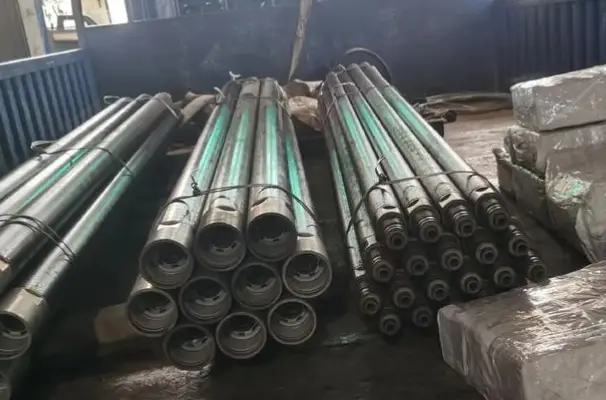API Spec 7-1 Heavy Weight Drill Pipe: Specifications, Inspection Standards, and Importance in Oil & Gas Operations
In the oil and gas industry, the safety and efficiency of drilling operations depend heavily on the integrity of the drill pipe, which forms the backbone of the drill string. API Spec 7-1 Drill Pipe, a critical standard developed by the American Petroleum Institute (API), ensures that drill pipes meet the highest standards for strength, durability, and safety. This article provides a comprehensive overview of API Spec 7-1 drill pipe specifications, the importance of regular inspections, and why adhering to these standards is essential for safe and effective oil and gas drilling.
What is API Spec 7-1 Heavy Weight Drill Pipe?
API Spec 7-1 is the American Petroleum Institute's specification for drill pipe used in the oil and gas industry. The specification outlines the material, design, and testing requirements for drill pipes, ensuring that they are strong enough to withstand the high stresses encountered in drilling operations. Drill pipes are tubular steel components fitted with tool joints that connect to other parts of the drill string. These pipes are used to transmit drilling fluid and torque to the bit, enabling the drilling process to penetrate rock formations.
Drill pipes manufactured according to API Spec 7-1 are used for various applications, including deep well drilling, directional drilling, and offshore drilling. API Spec 7-1 defines the minimum mechanical properties, including tensile strength and yield strength, for various grades of drill pipe to ensure that they can handle extreme conditions encountered in deep drilling operations.
Grades of Drill Pipe and Their Specifications
API Spec 7-1 includes a variety of grades for drill pipes, each designed to handle different levels of stress and pressure encountered during drilling. Some of the most common grades of drill pipe include:
E-75 (Grade E) – This is the most commonly used grade for general-purpose drilling. It has a minimum yield strength of 75,000 psi and is suitable for shallow to medium-depth wells.
X-95 – This grade has a minimum yield strength of 95,000 psi and is often used in medium to deep well drilling operations where higher strength is required.
G-105 – With a minimum yield strength of 105,000 psi, this grade is used in deep wells and highly demanding drilling conditions.
S-135 – This high-strength grade, with a minimum yield strength of 135,000 psi, is used in ultra-deep wells and high-pressure environments.
V-150 – Although not an API standard grade, V-150 drill pipe is commonly used in specific high-pressure applications where even greater strength is needed, offering a minimum yield strength of 150,000 psi.
Importance of API Spec 7-1Heavy Weight Drill Pipe Inspections
Routine inspections of drill pipes are essential to maintain the integrity and safety of the entire drilling operation. The API standard specifies the methods for inspecting drill pipes, ensuring that they are free from defects such as cracks, corrosion, or wear. The inspections typically involve visual checks, ultrasonic testing, and magnetic particle testing to identify any structural weaknesses.
Why Inspect Drill Pipes?
Drill pipes are exposed to extremely high stresses, especially during fracturing operations, where fluid pressures can exceed 15,000 psi. If a pipe is compromised, it can fail rapidly, leading to significant safety risks, downtime, and equipment damage. Failing to inspect drill pipes regularly could result in catastrophic consequences, including blowouts, fires, or explosions.
During fracturing, even a single failed joint can cause operational delays, and the time-sensitive nature of drilling operations means that a failure can be disastrous. The risks of a fractured pipe extending into gas or oil reservoirs could result in significant environmental hazards, including spills and fires. Regular inspections can prevent such accidents, ensuring that any pipe showing signs of wear or damage is re-certified or replaced before it becomes a safety hazard.
Consequences of Not Inspecting Drill Pipes
Without proper inspections, drill pipes may develop fatigue cracks or fail under high-pressure conditions. Such failures are often due to corrosion, material defects, or wear from prolonged use. As the pipe undergoes repetitive cycles of stress and pressure, any undetected flaw can cause catastrophic failures, leading to expensive downtime, increased operational costs, and safety incidents.
API Standards for Drill Pipe Inspections
The API has set forth several specifications to guide the inspection of drill pipes. These include:
API 5A – This standard provides requirements for the inspection and testing of drill pipe materials to ensure they meet the necessary mechanical properties and dimensions.
RP 7G-2 – This recommended practice outlines the procedures for inspecting drill pipe connections and tool joints.
API 5DP – A specification dedicated to the drill pipe used in oil and gas drilling operations, specifying minimum requirements for material properties, dimensions, and performance characteristics.
What Does API Do?
The American Petroleum Institute (API) plays a crucial role in developing standards for the oil and gas industry, particularly in ensuring that drill pipes and other equipment meet rigorous safety and operational requirements. By developing and updating these standards, API helps to address potential risks and promote public safety. API standards are developed based on input from industry leaders, manufacturers, and operators, ensuring that they are based on real-world operational experiences.
Conclusion
API Spec 7-1
Drill Pipe is an essential specification in the oil and gas industry, providing the necessary strength and durability for deep and ultra-deep
drilling operations. Regular inspections and adherence to API standards are crucial to prevent operational failures and ensure the safety of drilling operations. By following API's guidelines, companies can reduce the risk of catastrophic events such as blowouts and equipment failure, ultimately leading to more efficient and safer drilling operations.






 English
English Español
Español بالعربية
بالعربية











 Phone :
Phone :  Whatsapp :
Whatsapp :  Email :
Email : 


